Priming the fuel filter is a crucial step in maintaining the efficiency and performance of a vehicle’s fuel system. The fuel filter plays a vital role in trapping impurities and contaminants before they reach the engine, ensuring clean and uninterrupted fuel flow. However, after changing the fuel filter or any work on the fuel system, it is often necessary to prime the filter to eliminate air pockets and ensure a smooth start. In this comprehensive guide, we delve into the intricacies of how to prime fuel filter.
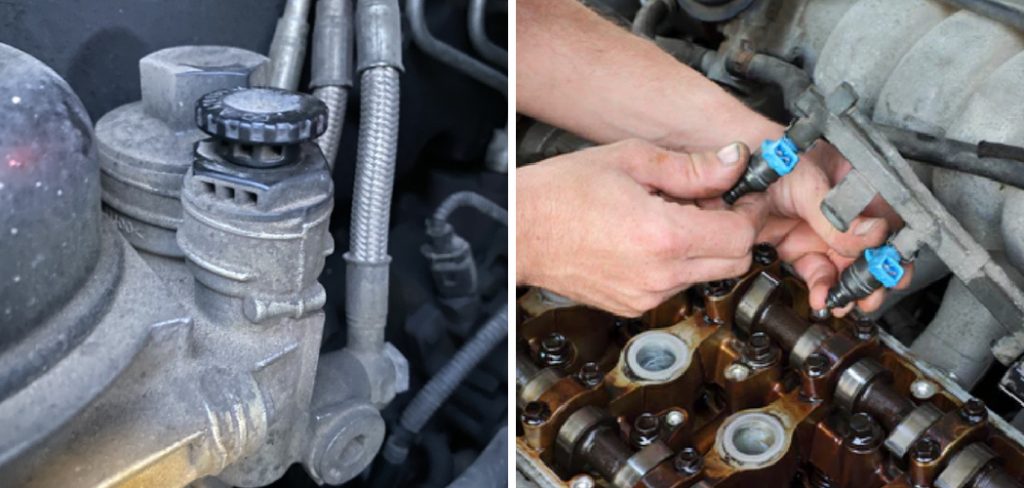
Whether you are a seasoned mechanic or a DIY enthusiast, understanding this process empowers you to maintain a properly functioning fuel system, promoting optimal engine performance and fuel efficiency. From the basics of locating the fuel filter to step-by-step priming procedures, this guide equips individuals with the knowledge needed to undertake this essential task for a reliable and smooth-running vehicle.
Importance of Priming the Fuel Filter
Priming the fuel filter is integral to maintaining a vehicle’s fuel system. When the fuel filter is replaced, air naturally enters the system, and without proper priming, this air can prevent the engine from receiving the fuel it requires to operate. Air pockets within the fuel lines not only make it difficult to start the vehicle but can also lead to inconsistent engine performance and reduced fuel pressure.
Priming the filter correctly ensures that any trapped air is purged, thus enabling a concentration of pure fuel to reach the engine for a clean and efficient combustion process. This simple yet critical maintenance task helps in avoiding potential engine sputter, misfires, or in severe cases, complete engine shutdown.
The Fuel Filter’s Role in The Fuel System
The fuel filter acts as a guardian for the engine, shielding it from various impurities that might be present in the fuel. Over time, the fuel that is delivered to your vehicle through refueling can accumulate contaminants such as dirt, rust, and sediment from fuel storage tanks or the natural environment. These foreign particles can significantly hinder engine performance if allowed to pass through.
Positioned within the fuel line, the filter’s role is to capture these contaminants before they reach the engine’s fuel injectors or carburetor. A clean and well-functioning fuel filter ensures that only clean fuel is delivered to the engine, which is essential for maintaining optimal engine operation, fuel economy, and the long-term health of the vehicle’s fuel system.
Understanding the Fuel Filter
The fuel filter, typically made from a pleated, paper-like material encased in a metal or plastic housing, operates under the hood unnoticed but is paramount in its role. It is strategically placed along the fuel line, normally between the fuel pump and the injectors or carburetor. Depending on the vehicle, a fuel filter can be found in varied locations such as mounted to the firewall, positioned near the fuel tank, or integrated into the fuel pump assembly itself.
Over its service life, the filter traps contaminants and must be replaced periodically to prevent clogging, which could lead to fuel starvation. Recognizing its critical function in vehicle maintenance and engine health, it’s important to know when and how to service the fuel filter to prevent unexpected downtime and costly repairs.
Locating the Fuel Filter
Identifying the exact location of the fuel filter is the first step before you can begin the priming process. Generally, the position of the fuel filter can be found in the vehicle’s service manual, which provides specific details according to the model and make. Commonly, the filter is placed along the fuel line, which runs from the fuel tank to the engine.

In many modern vehicles, it may be located near the fuel tank underside for easy access, or it could be in the engine bay, mounted on the firewall or near other engine components. Some vehicles feature a fuel filter that is part of the fuel pump assembly inside the fuel tank, requiring more intricate service procedures. It is crucial to properly identify the filter’s location to ensure a safe and effective maintenance process.
10 Methods How to Prime Fuel Filter
1. Manual Priming:
Manual priming involves manually filling the fuel filter with fuel to remove any air trapped in the system. To perform manual priming, locate the primer bulb or hand pump on the fuel filter housing. Squeeze or pump the primer bulb several times until resistance is felt, indicating that the fuel filter is filled with fuel. This method may require multiple squeezes or pumps to ensure complete priming. Once the fuel filter is primed, start the engine and check for proper fuel flow.
Manual priming can be a useful technique in situations where the vehicle has been sitting for an extended period of time and air has entered the system. It can also be helpful when changing the fuel filter or performing maintenance on the fuel system. However, it should not be used as a regular maintenance practice, as it can introduce contaminants into the fuel system if not done properly.
2. Gravity Feed:
Gravity feed priming utilizes the force of gravity to fill the fuel filter with fuel. To prime the fuel filter using gravity feed, disconnect the fuel line from the outlet side of the filter and place it in a container filled with diesel fuel.
Allow the fuel to flow through the line and into the filter by gravity alone. This method may take some time, but it effectively removes air from the system. Once the filter is full, reconnect the fuel line and continue with your normal starting procedures.
This method is commonly used when you need to change a fuel filter or if there has been air introduced into the system. It is important to note that gravity feed priming may not be as effective on newer vehicles with highly pressurized fuel systems. In these cases, it is recommended to use a hand pump or electric fuel pump to prime the system.

Gravity feed priming is a simple and effective way to remove air from your fuel filter. It can be done with minimal tools and equipment, making it a convenient method for roadside repair or in emergency situations. However, it is important to note that this method may not work for all types of vehicles and fuel systems. It is always best to consult your vehicle’s manual or a professional mechanic for the most appropriate priming method.
3. Bleeder Screw Method:
Some fuel filters come equipped with bleeder screws that allow trapped air to escape from the filter housing. To prime the fuel filter using the bleeder screw method, locate the bleeder screw on the filter housing and loosen it slightly. Pump the primer bulb or hand pump until fuel begins to flow steadily from the bleeder screw. Once steady fuel flow is achieved, tighten the bleeder screw to seal the system.
One benefit of using the bleeder screw method is that it allows for a more precise and controlled priming process. This can be especially helpful when working with sensitive or delicate fuel systems.
Additionally, the bleeder screw method can be used as a diagnostic tool. If air continues to flow from the bleeder screw even after multiple attempts at priming, it may indicate that there is a leak in the fuel system that needs to be addressed.
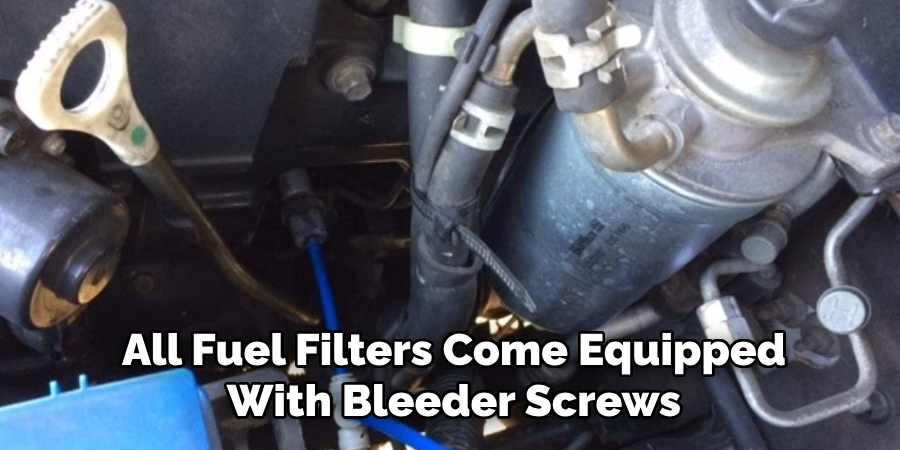
It’s important to note that not all fuel filters come equipped with bleeder screws, so this method may not be an option for all vehicles. In these cases, other priming methods such as using a hand pump or manually filling the filter housing may need to be used.
4. Electric Fuel Pump:
An electric fuel pump can be used to prime the fuel filter by creating pressure in the fuel system and pushing fuel through the filter. To prime the fuel filter using an electric fuel pump, connect the pump to the fuel line leading to the filter inlet. Activate the pump to pressurize the fuel system and force fuel through the filter, removing air in the process. This method is quick and efficient but requires access to an electric fuel pump.
In addition to priming the fuel filter, electric fuel pumps are also commonly used in vehicles with electronic fuel injection systems. These systems use pressurized fuel to inject precise amounts of fuel into the engine’s cylinders for optimal performance. Electric fuel pumps provide a constant flow of pressurized fuel, ensuring that the engine receives the correct amount of fuel at all times.
One of the main advantages of electric fuel pumps is their ability to be mounted externally or internally in a vehicle. This flexibility allows for easy installation and replacement, as well as protection from potential damage due to external elements. Additionally, electric fuel pumps tend to have fewer mechanical parts compared to traditional mechanical fuel pumps, which can reduce the chances of failure and maintenance needs.
5. Fuel Injector Pump Priming Lever:
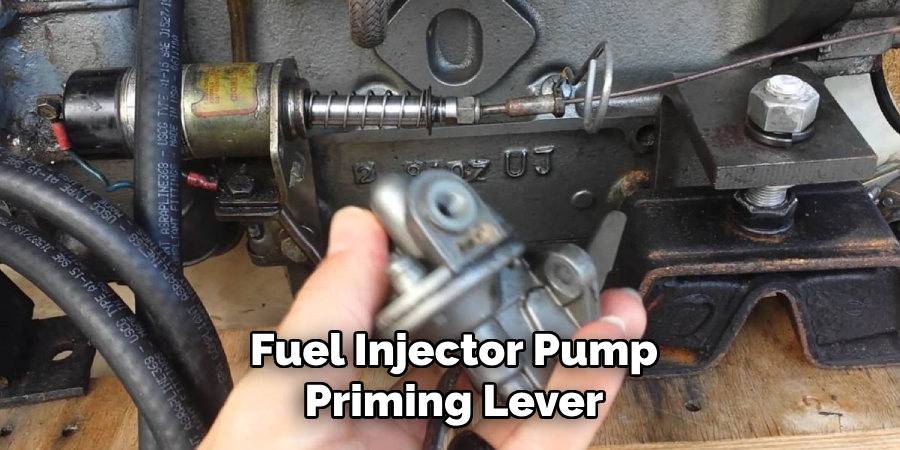
Some diesel engines are equipped with a fuel injector pump priming lever that can be used to manually prime the fuel filter. To prime the fuel filter using the priming lever, locate the lever on the fuel injector pump and operate it according to the manufacturer’s instructions.
This lever pumps fuel through the system, removing air and ensuring proper priming of the fuel filter. Once the fuel filter is properly primed, the lever should return to its original position.
It is important to regularly check and maintain the fuel injector pump priming lever. If it becomes stuck or difficult to operate, it may indicate a problem with the fuel system that should be addressed immediately.
Additionally, proper use of the priming lever can prolong the life of your engine by ensuring a consistent and clean fuel supply. Regularly checking and maintaining the lever can help prevent costly repairs down the line.
Another important aspect to consider when using the fuel injector pump priming lever is the quality of diesel fuel being used. Contaminated or poor-quality fuel can cause issues with the fuel system, leading to clogs and malfunctions. It is important to regularly check the fuel for water or sediment and to use high-quality diesel fuel from a reputable source.
6. Pre-Filled Fuel Filter:
Pre-filling the fuel filter with fuel before installation can help expedite the priming process. To pre-fill the fuel filter, fill the filter housing with diesel fuel before installing it in the vehicle. Ensure that the filter is securely sealed to prevent leaks. Once installed, the pre-filled filter will require minimal priming to remove any remaining air from the system.
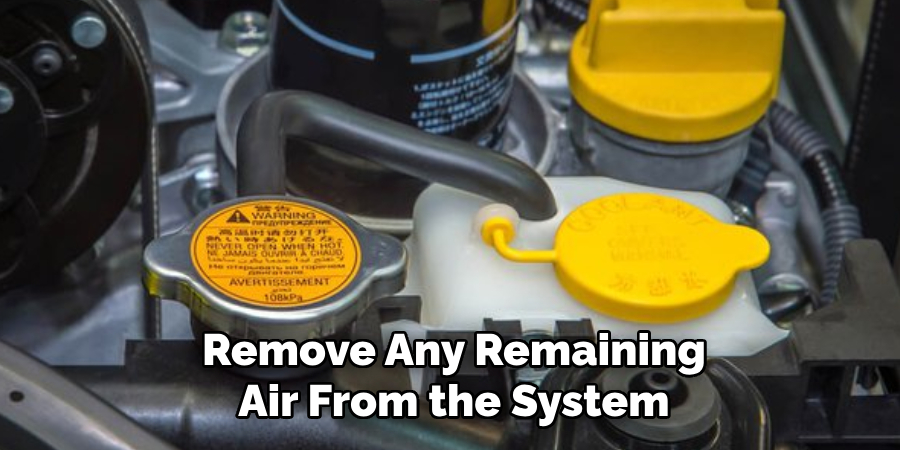
This process can save time and effort, especially in colder climates where the fuel is thicker and harder to prime. However, it is important to note that not all fuel filters are designed to be pre-filled. Be sure to consult the manufacturer’s instructions before attempting this method.
7. Cranking the Engine:
Cranking the engine without starting it can help prime the fuel filter by drawing fuel through the system and removing air pockets. To prime the fuel filter using this method, turn the ignition key to the “crank” position without starting the engine.
Allow the engine to crank for several seconds, then release the key. Repeat this process several times until the engine starts or fuel is visible at the filter outlet. This process may also help if the engine is struggling to turn over due to a weak battery or other starting issues.
After priming the fuel filter, it is important to check for any leaks and ensure that all connections are secure. If there are no visible leaks, start the engine and let it run for a few minutes before shutting it off. This will allow the fuel system to fully pressurize and ensure that all air pockets have been removed.
It is also a good idea to periodically check and replace the fuel filter according to the manufacturer’s recommended schedule. A clogged or dirty fuel filter can lead to engine performance issues and should be addressed as soon as possible.
8. Using a Vacuum Pump:
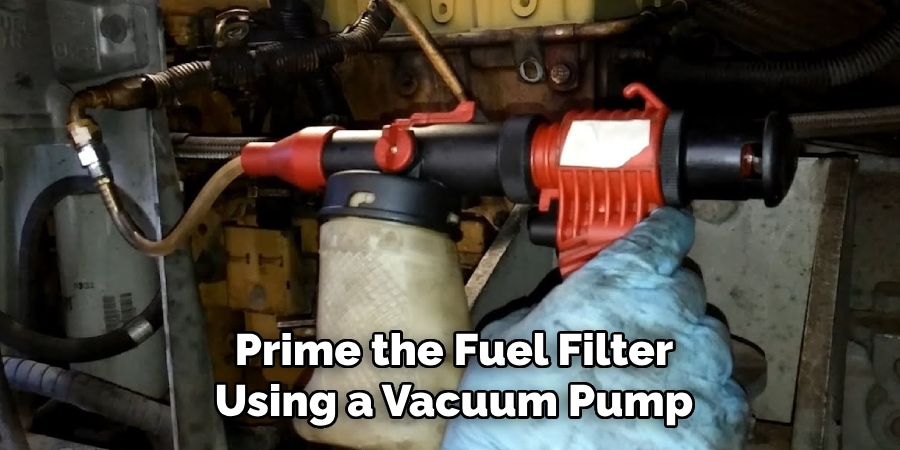
A vacuum pump can be used to create suction in the fuel system and draw fuel through the filter, removing air in the process. To prime the fuel filter using a vacuum pump, connect the pump to the fuel line leading to the filter inlet. Activate the pump to create suction, which will pull fuel through the system and fill the filter. This method is effective for removing air from hard-to-reach areas of the fuel system.
The use of a vacuum pump is not limited to just priming the fuel filter. It also has other practical applications in the automotive industry, such as testing for leaks in the engine and braking system. By creating negative pressure, a vacuum pump can help identify leaks by detecting any changes in suction or air flow.
In addition, vacuum pumps are commonly used for various maintenance tasks in industrial settings, such as removing unwanted gas or liquid from a closed system. They can also be used for medical purposes, such as suctioning fluids during surgery.
9. Bleeding Injectors:
Bleeding the fuel injectors can help remove air from the fuel system and ensure proper priming of the fuel filter. To bleed the injectors, locate the injector bleed screws on the fuel lines and loosen them slightly. Crank the engine or activate the fuel pump to pressurize the system and purge air from the injectors.
Once steady fuel flow is achieved, tighten the bleed screws to seal the system. It is recommended to bleed the fuel injectors every 6 months or 10,000 miles to ensure optimal performance of your vehicle. While bleeding the injectors, it is also a good idea to inspect the fuel lines and connections for any signs of wear or leaks.
10. Using a Fuel Primer Tool:

A fuel primer tool is specifically designed to facilitate the priming of fuel filters and remove air from the fuel system. To use a fuel primer tool, connect it to the fuel line leading to the filter inlet and activate the tool according to the manufacturer’s instructions. The tool creates pressure in the fuel system, forcing fuel through the filter and removing air in the process. This method is efficient and requires minimal effort.
Additionally, fuel primer tools can also be used to diagnose any air leaks in the fuel system. If there is a leak, the pressure from the tool will decrease rapidly and indicate where the leak is located. This can save time and effort in troubleshooting and repairing any issues with your fuel system.
Conclusion
In conclusion, mastering the art of priming a fuel filter is an essential skill for any vehicle owner or mechanic. The process outlined above provides a clear and systematic approach to ensure proper priming, safeguarding the engine against potential damage and ensuring optimal performance.
Regular maintenance, including the timely priming of the fuel filter, is crucial in preserving the longevity of your vehicle and preventing costly repairs. As we conclude, it is imperative to emphasize the importance of following manufacturer guidelines and recommendations specific to your vehicle model.
By incorporating these priming techniques into your routine maintenance schedule, you contribute to the overall health and efficiency of your engine. Follow these simple instructions outlined in this blog post about how to prime fuel filter, and you’ll be able to get the job done with ease.

Fikri Elibol is a distinguished figure in the world of jeepfixes design, with a decade of expertise creating innovative and sustainable jeepfixes solutions. His professional focus lies in merging traditional craftsmanship with modern manufacturing techniques, fostering designs that are both practical and environmentally conscious. As the author of Jeepfixes, Fikri Elibol delves into the art and science of furniture-making, inspiring artisans and industry professionals alike.
Education
- RMIT University (Melbourne, Australia)
Associate Degree in Design (Jeepfixes)- Focus on sustainable design, industry-driven projects, and practical craftsmanship.
- Gained hands-on experience with traditional and digital manufacturing tools, such as CAD and CNC software.
- Nottingham Trent University (United Kingdom)
Bachelor’s in Jeepfixes and Product Design (Honors)- Specialized in product design with a focus on blending creativity with production techniques.
- Participated in industry projects, working with companies like John Lewis and Vitsoe to gain real-world insights.
Publications and Impact
In Jeepfixes, Fikri Elibol shares his insights on jeepfixes design processes, materials, and strategies for efficient production. His writing bridges the gap between artisan knowledge and modern industry needs, making it a must-read for both budding designers and seasoned professionals.
